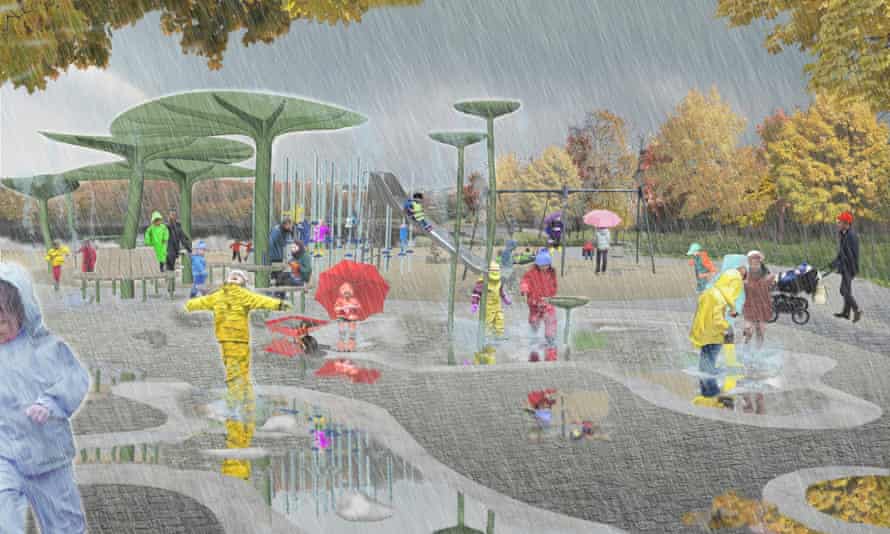When they wake up on a Saturday morning to find rain coursing down the windows of their Gothenburg apartment, four-year-old Enja Bäckström and her six-year-old brother Charlie often still want to go out to play.
That’s because their local playground has been designed to be particularly fun when it’s wet. There are dips in the ground to make the puddles deeper and more satisfyingly splashy, and water gushes down channels from lilypad-shaped rain shelters into a sandpit where children can make pools, rivers and dams. “The kids love to go on their bicycles through the puddles, and my son likes to dig the sands, so some parts of the playground are really nice when it rains,” says their mother, Jessica Bäckström.
The Regnlekplatsen, or “rain playground”, is part of Rain Gothenburg, a bold plan to be “the best city in the world when it’s raining”.
“The tourist agency has only wanted to sell pictures of a sunny Gothenburg, even though it rains here nearly 40% of the time,” explains Jens Thoms Ivarsson, the artist and designer hired more than three years ago to develop the project. “What we’re looking at is: how can we use the fact that it rains quite a lot in Gothenburg in a creative way? What if we can turn the rain into an asset for the city?”
Since he was employed full-time at the city’s water and waste disposal department, Thoms Ivarsson has launched an annual competition to have poems cast on to manhole covers, helped set up two rain playgrounds, and launched several art and dance projects – including one where polar bear footprints have been painted across the city’s Esperantoplatsen square using special paint so that they only appear when it is raining.
He has hired the Danish public art collective Superflex to come up with Rain Station 365, an as yet unbuilt sculpture, and worked to push the Rain Gothenburg idea into every part of city planning, from new schools to housing development, to work with homeless people.
“I work with architects and they go: ‘Oh, we never thought about that before. We always just thought how can we get rid of the rain,’” Thoms Ivarsson says of his collaborations. “And now they’re going: ‘Wow, it’s a new world opening up.’ I mean, it’s been falling on our head forever, but now can we use it at least?”

Other rainy places have taken notice. Before the pandemic, Thoms Ivarsson had been out spreading his message in Glasgow, London, Dordrecht and Amsterdam, and now that the pandemic is forcing us outside whatever the weather, the message is arguably even more relevant. Last month he told a festival in the wet-weathered Irish town of Sligo that it should reimagine its relationship with rain.
But Bergen, hands-down Europe’s rainiest city, has so far been resistant. “They’ve missed the opportunity,” he complains. “When you go to their tourist website, 99% of the pictures are of sunny, beautiful days, but it rains there 256 days a year. They try to close their eyes to the fact that it’s a rainy city, because they see it as something bad.”
One of the best examples of the Rain Gothenburg approach is the design for a new school, Torslandaskolan, the competition for which was titled “The world’s best school when it’s raining”. Under the winning proposal, by Stockholm’s Link Arkitektur, rainfall from the roofs will be channelled down wide pipes on the side of the building into pools, then towards a river or canal that runs through the schoolyard, where it can be controlled with sluices, and then through a “glacial area” where the water is broken up by concrete blocks, before seeping away into a natural delta marshland of puddles and stepping stones. Over one entrance, rainwater will cascade down a waterfall.
“The schoolyard will change naturally and have a different appearance when the weather is different,” says Anna Rolf, one of the architects who worked on the design. “Normally you just try to take all the water away and want it to be clean and look the same every day.”
On dry days, the riverbed can be used for skateboarding (outside school hours). The marshland will feature different types of vegetation and, crucially, real mud. “There’s been a decision that it’s OK for them to get muddy, and there will be hoses outside so you can wash the kids before they go back inside,” Rolf says.

The Rain Gothenburg project was launched as part of the 400th anniversary of the city’s founding by Gustav II Adolf, the king who for a short period turned Sweden into a major European power. But if Thoms Ivarsson and the project leader, Magnus Mott, have their way, it will become a permanent part of the way the city is run. After all, climate change means a lot of cities are going to get wetter, so we may as well seek to enjoy it.
“We need to deal with the rain in a smart way so that we create sustainable, resilient and resistant cities,” Thoms Ivarsson says, predicting that this will mean building a lot of new drainage and water management infrastructure. “Usually, that is done by engineers and technicians, and that usually ends up with really ugly, boring and horrible installations, because they don’t give a single thought to the fact that there are actually humans living in the city.”
If handled right, though, he argues, a rain-positive approach could be like the High Line in New York, a project that turned something unwanted – a disused elevated railway – into a wonderful linear park. Now he wants at least a third of Gothenburg’s playgrounds to be rain playgrounds.
Even after they got a donor to fund the construction, city officials refused to finance the maintenance of Rain Station 365. So Thoms Ivarsson and Mott are on their second attempt to find a site for the petrol-station-shaped fountain, which features a canopy that people can shelter under when it’s raining and from which rain falls when it’s dry.
“I think Gothenburg has still a long way to go,” he says. “But now things are really starting to happen here.”


Average Rating